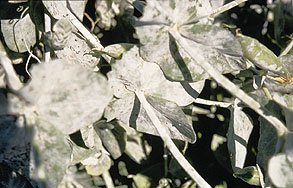Powdery Mildew
Powdery mildew is a widespread disease that is often most prevalent on late- maturing field peas. In severe infestations, brown, pitted spots may occur on pods and the seed may be visibly affected. Premature ripening may result in shrunken seed.
Host Crops
Field peas
Biology
Powdery mildew overwinters on plant debris. It appears as cottony-white to tan fungal colonies and yellowed blotches on the upper and lower surfaces of the leaves. It develops more severely on the lower leaves but it can infect any of the leaves in cool, humid weather. When the disease is severe, the peas are stunted, turn yellow, and defoliate.
A lush stand of peas is an ideal environment for powdery mildew development. Dew formation and lack of rainfall also favour the development of the disease. Optimum temperatures for development are between 20-25 degrees C (68-75 degrees F). Rain showers are actually disruptive to the spread of powdery mildew. The inoculum is spread by wind. Once it is established, powdery mildew increases very rapidly.

Photo Courtesy of: Western Committee on Plant Diseases
Symptoms Of Damage
Symptoms consist of a light, greyish, powdery growth on the leaves, pods and occasionally on the stems. This powdery growth is easily rubbed off. As the plant ages, tiny fruiting bodies of the fungus often form in the powdery growth.
Scouting Techniques
Look for powdery white growth on leaves and pods. They develop as spots that enlarge and merge to cover the entire surface of the leaves, pods and stems.
Control Tips
- Early seeding is recommended because powdery mildew infection is more damaging on late-maturing pea crops. Most varieties are susceptible to powdery mildew but resistant varieties are available. Consult the provincial seed guide for current information. Crop rotation with non-related crops will help.
- Field isolation may assist in reducing infection which occurs by wind movement.
- Avoid heavy application of fertilizer.
- Foliar fungicides should only be necessary when the disease appears early in the growing season or if the crop was planted late.
For further information, contact your GO representative.

